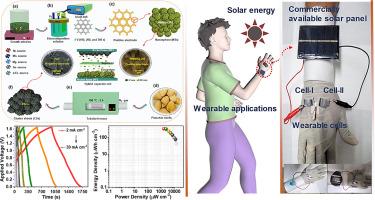设计用于可穿戴半固态混合电容器的三金属Ni-Mg-Mn硒化和生物衍生碳电极
IF 13.8
1区 材料科学
Q1 METALLURGY & METALLURGICAL ENGINEERING
引用次数: 0
摘要
由于其高导电性、丰富的氧化还原活性、结构坚固性和孔隙性,三金属硒化物已成为可穿戴超级电容器应用的有前途的电极。本文采用低成本、快速的电沉积技术制备了具有良好纳米球形貌的三金属硒化镍镁锰(NMMSe)电极。系统地研究了NMMSe电极作为正极的电化学性能。沉积时间为200 s的NMMSe电极(记为NMMSe-200)在4 mA cm -2时具有439.4µAh cm - 2/225.6 mA h g - 1的高面积/比容量,并具有良好的循环稳定性。为了进一步研究沉积时间对纳米结构评价和电化学行为的影响,在生长时间为100和300 s时合成了额外的NMMSe电极。负极采用从开心果壳废料中提取的活性炭(即多孔活性炭(PAC)),具有913.4 mF cm−2的高面电容和320.6 m2/g的优良表面积。最后,以NMMSe-200为正(+)电极,PAC为负(-)电极,组装了半固态混合电容器(HC)电池。由此得到的NMMSe//PAC/镍泡沫HC电池在2 mA cm - 2时具有令人印象深刻的928.8 mF cm - 2的面电容,338.5µWh cm - 2 (56.4 Wh kg - 1)的高能量密度,以及出色的循环稳定性。这些结果突出了NMMSe-200电极在高性能可穿戴储能系统中的强大潜力。本文章由计算机程序翻译,如有差异,请以英文原文为准。

Designing trimetallic Ni-Mg-Mn selenide and bio-derived carbon electrodes for wearable semi-solid-state hybrid capacitor applications
Trimetallic selenides have emerged as a promising electrode for wearable supercapacitors applications, due to their high electrical conductivity, rich redox activity, structural robustness, and porosity. In this report, a trimetallic nickel–magnesium-manganese selenide (NMMSe) electrode with a well-defined nanosphere morphology was prepared using a low-cost and rapid electrodeposition technique. The electrochemical performance of the NMMSe electrodes was systematically investigated as a positive electrode. The NMMSe electrode prepared with a deposition time of 200 s (denoted as NMMSe-200) revealed a high areal/specific capacity of 439.4 µAh cm−2/225.6 mA h g−1 at 4 mA cm–2, along with excellent cycling stability. To further investigate the effect of deposition time on the nanostructure evaluation and electrochemical behavior, additional NMMSe electrodes were synthesized at the growth times of 100 and 300 s. For the negative electrode, activated carbon derived from pistachio shell waste (i.e., porous activated carbon (PAC)) was employed, demonstrating a high areal capacitance of 913.4 mF cm−2 and an excellent surface area of 320.6 m2/g. Finally, a semi-solid-state hybrid capacitor (HC) cell was assembled using NMMSe-200 as the positive (+) electrode and PAC as the negative (-) electrode. The resulting NMMSe//PAC/nickel foam HC cell delivered an impressive areal capacitance of 928.8 mF cm−2 at 2 mA cm–2, a high energy density of 338.5 µWh cm–2 (56.4 Wh kg−1), and exceptional cycling stability. These results highlight the strong potential of NMMSe-200 electrodes for high-performance, wearable energy storage systems.
求助全文
通过发布文献求助,成功后即可免费获取论文全文。
去求助
来源期刊

Journal of Magnesium and Alloys
Engineering-Mechanics of Materials
CiteScore
20.20
自引率
14.80%
发文量
52
审稿时长
59 days
期刊介绍:
The Journal of Magnesium and Alloys serves as a global platform for both theoretical and experimental studies in magnesium science and engineering. It welcomes submissions investigating various scientific and engineering factors impacting the metallurgy, processing, microstructure, properties, and applications of magnesium and alloys. The journal covers all aspects of magnesium and alloy research, including raw materials, alloy casting, extrusion and deformation, corrosion and surface treatment, joining and machining, simulation and modeling, microstructure evolution and mechanical properties, new alloy development, magnesium-based composites, bio-materials and energy materials, applications, and recycling.
 求助内容:
求助内容: 应助结果提醒方式:
应助结果提醒方式:


